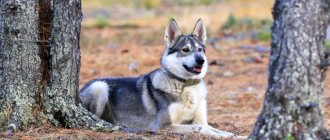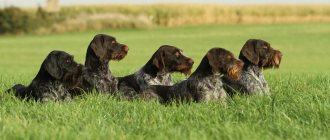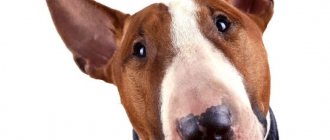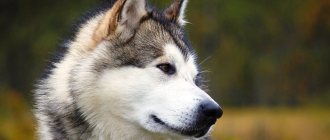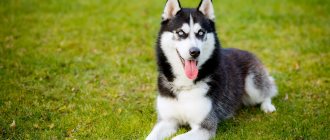1889
Author of the article
Ekaterina Andreeva
Reading time: 2 minutes
A A
Proper education and training of an Akita Inu will make him obedient, brave, friendly and loyal. This breed is suitable for organizing protection, searching and hunting such large animals as, for example, a wild boar or a bear. Using training that develops natural instincts, you can achieve a lot from a dog. Your pet should be rewarded for completing tasks correctly and quickly. I would like to note right away that the character of these dogs is somewhat capricious and proud. This breed does not tolerate pronounced superiority and dominance of humans and, if the wrong training methods are used, the dog will become cowardly or, on the contrary, evil.
What to pay attention to in training
Representatives of the ancient Japanese breed are smart but stubborn dogs.
They do not obey the first requirement and consider training a useless exercise. Only respect for the owner makes the dog obey. Before training, consider several points:
- Akita Inu training is based on praise. Punishments are excluded and prohibited. Raising your voice, pulling back on the collar or leash causes distrust, refusal to obey, and lack of reaction to the nickname. Point out bad behavior with a rather displeased intonation, leaving without a treat;
- The dog is easily distracted. If music starts playing, a cat runs by, a person passes by, the animal will switch its attention from training. There is no need to get angry at a puppy or an adult dog. Let your pet satisfy its natural curiosity, then you can continue the activity;
- The owner needs to be a leader. The dog should see him as a leader who is respected for justice, calmness, and love. Intimidation and demands to obey by any means cannot achieve an obedient attitude;
- It is better to teach him commands during a walk between feedings. It is difficult to train a well-fed pet with tasty food; hunger will become a stimulus. The treat is given immediately after the correct execution of the command. Hard cheese, dried meat, and store-bought food are good options. Portions should be small;
- The dog must carry out the new command immediately. If the animal does not comply, no treat is given. Then they move on to practicing another action;
- Aggression towards other people or animals is stopped immediately, but without punishment. The dog will not tolerate such an attitude towards himself. It's better not to pay attention for a while;
- Living conditions in a private house or spacious apartment are important. They communicate a lot with dogs of this breed, walking at least 3 hours a day. Early socialization is important for puppies to teach them commands in different situations. Older dogs should wear a muzzle when walking in crowded places.
- Classes with a dog handler are recommended. It is difficult for an inexperienced dog breeder to train this breed; such courses are necessary for him.
Akita Inu are independent, proud, intelligent animals. Puppies begin to be raised from the first days of their arrival in the family, and real training is successful only with mutual respect with the person.
Take the Attention Test! Find 10 differences! (click right here!)
Find the answer Are you bothered by some problem or question? Enter “Breed” or “Name of the problem” into the form, press Enter and you will find out everything about the issue that interests you.
Raising a dog
Education is the process of shaping Akita Inu behavior acceptable to the owner, when this behavior is not regulated by commands. During upbringing, a dog develops relationships with its owner, family members, passers-by, behavior in the house, on the street, and relationships with other dogs. The training process begins immediately when the dog first appears in the house and continues throughout the dog’s life. Regardless of the dog's breed, it must be trained. Just as people do not like ill-mannered people, dogs should also know what is allowed and what is not allowed. Raising a dog is a rather complex process, which is not limited to learning just a few commands. The main goal of education is that the dog should become pleasant to talk to. In addition, it must be manageable at some points, otherwise it will be very difficult for the dog owner. In the broadest sense of the word, dog training is about teaching the dog commands such as “Bad” and “No”. But besides this, the dog must know what is good and what is bad, even in those moments when the owner is not around. Some people believe that the Akita Inu only understands commands, but cannot generalize. Only those who, as a rule, never had dogs, and studied them only in laboratory conditions, in which dogs were not able to show their full potential, are convinced of this, as well as those who, due to their personal qualities, were unable to establish a relationship with pet. In real life, the Akita Inu is a pack animal and therefore, like any other pack animal, needs to communicate with members of its family. In this situation, the dog’s family members are people. It is quite stupid to think that if a dog caresses you, this means that his skin is itching. In order for a dog’s nervous system to function normally, it needs affection, love, communication, and praise. In addition, so-called “inhibiting factors” are required, because if the dog is allowed everything, then this will not lead to anything good. When raising an Akita Inu puppy, you should pay attention to the genetic characteristics of the breed. A family is a pack in which there must be a leader, in this case the leader is a person. The leader punishes, plays, feeds, caresses, praises and scolds. All other members of the owner's family are ranked by rank. At that moment, while the puppy is small, all other family members are senior to him. However, in the process of growing up, around the age of one year, the dog begins to look for its place in the hierarchical pyramid. Naturally, she will try to take the step that is as high as possible. She can do this with the help of force, in the case of large dogs, or with the help of cunning, as small dogs do. The more ill-mannered the dog is, the more difficult this process will be. If the owner from the first days shows his pet that the one who has the power is right, then he will turn out to be a frail neurotic or an evil beast with whom you will hardly communicate with joy. An Akita Inu puppy must understand that he must obey people, since they love him, feed him, and raise him. Understand that prohibitions are not the whim of the owner, but a way to protect everyone from trouble. The main influence on the dog should be the voice. From the first days of being in your home, the puppy must realize that you love him, and if you raise your voice, then this means that he is doing something wrong. One of the best incentives for a pet is considered to be a treat, which should be given out for good behavior and listening to commands.
Owner experience
Do not train your baby if you are in a bad mood, dogs are excellent psychologists, and your depression can rub off on them. Both puppies and adults copy their owner in everything; a loving dog will try to be with you.
Dogs are able to find a special approach to everyone in order to satisfy their whims. There are no two identical puppies or adult pets; each has a different character and habits.
His character in the future depends on training. It depends on you whether your pet will grow up to be a cheerful and devoted friend or a nervous, unsociable creature.
Appearance of the breed
The American Akita is a Spitz-type breed with a large, powerful body, a large bear-like muzzle, and straight, triangular ears. The weight of an adult dog is about 60 kg for a male (body height up to 70 cm) and 50 kg for a female (height at the withers up to 65 cm).
- Wool. The breed description allows for any colors. If the dog is white, this is not considered a fault. The coat is short, long hair is considered a defect, such dogs are not allowed to participate in exhibitions. Double coat, with undercoat. The undercoat may differ in color from the main shade of the hair. There may be a black “mask” on the muzzle.
- Head. Large and powerful. The ears are shoulder-width apart. The muzzle is triangular. The eyes are small and deep. There may be a groove on the forehead. The jaws are similar to scissors or pincers. The teeth are straight, even, large. If a dog is missing two molar teeth, this is not considered a defect. The nose, eye rim and lips are pigmented.
- Ears. Erect, triangular in shape with rounded tips. If you pull your ears forward, they should reach the top edge of your eyes.
- Body. Strong, muscular. The length of the body is greater than the height at the withers by 10% in males and by 20% in females.
- Paws. Smooth, with well-developed muscles. The front and rear are the same in thickness. If the dog has extra (dewclaw) toes, they must be removed.
- Tail. According to the breed standard, the tail should reach the hock joint when extended. It is covered with profuse hair and should be wide at the base.
There are defects that may prevent an American Akita from participating in an exhibition; the breed standard does not allow the following defects:
- small stature (for males - up to 63 cm, for females - up to 58 cm);
- irregular pigmentation around the nose or its complete absence;
- malocclusion;
- straight, not curved tail;
- undescended testicles into the scrotum in males (cryptorchidism).
Why train
Training a dog at home has 3 goals:
- The pet must recognize the owner as a leader.
- The person will know well how to behave with the pet.
- A trained dog is a socially adapted pet.
The owner must choose whether to use deterrents or rewards for a motivational item.
The greatest impact is achieved when the dog receives praise right away.
Containment methods:
- Using objects that can attract the dog's attention. Things that make sharp sounds - whistles, a bunch of keys, a rattle from a tin can with pebbles, etc.
- If the actions are not followed, the dog loses the owner's attention. She is sent to her place without the usual stroking and praise, in a stern voice.
Pet restraint methods can be used on older puppies older than 4 months. If the dog is unbalanced, then this method should not be used.
Ignoring a pet is a more effective technique than physical influence.
Training is quite a labor-intensive task, but teaching a dog to behave correctly is easier than correcting inappropriate behavior.
How to feed an American Akita?
To understand what to feed an Akita, you need to know the history of the breed. Many members of the breed cannot eat chicken or wheat products. This is due to the Japanese origin of the dog; food of this type is not typical for the Land of the Rising Sun. But Akitas happily eat rice and fish - the traditional food of the Japanese.
It is better to choose a dry food that does not contain chicken and wheat.
It is important to remember the following:
- This breed is not prone to gluttony, but is very susceptible to volvulus. Therefore, feeding the American Akita should be fractional.
- The diet should include fish and meat (except poultry). This should be the basis of the American Akita's diet. All bones must be removed from the fish. You can give meat and fish food raw or stewed.
- Porridges that are useful for dogs are: rice, buckwheat, oatmeal. You can give vegetables: raw or stewed in vegetable oil.
- You should include fruits and berries in your diet; they are a healthy source of natural vitamins. Apples, pears, raspberries and cherries can be added to porridge.
- If the dog is fed prepared food, then you need to choose brands of food for large breeds of dogs. Akitas love dry food with the addition of rice and salmon.
For a novice trainer
To prevent training from turning into torture:
- Take your pet for a walk beforehand. A tired, running dog is less distracted. The effect will be greater. Active walking makes working with the animal easier.
- The command is spoken once.
- Take pauses. When practicing, for example, “near”, “lie down”, “fetch”, you need to give the dog time to take a breath. 5-10 seconds will be enough.
- Change the sequence. If the dog gets used to doing everything in order. That, for example, after “to me” you need to “sit.”
- You can't overload it. Too intense training can harm the animal.
An already trained dog follows commands under any conditions. But your pet may get tired.
- Sometimes students, like ordinary schoolchildren, “run away from class.” They may be distracted by a nearby cat or other animal. Be more careful with your exposure. Train her on a long leash. This will allow you to catch up with the “mischievous person”, even if he runs fast. A leash with a carabiner for 3-5 meters is suitable. Often such a leash is just needed for endurance and training to pick up “goodies” from the floor.
- “Mass” training is not allowed. Only the owner should act as a trainer. Otherwise the dog will be distracted.
- It's worth pausing. If the animal doubts the correctness of the actions, the reason is the load. Give your dog a simple command and then praise generously. When she sees that the owner approves of him, she will begin to perform the exercises better. Play or take a walk with her.
- Commands are studied systematically and gradually. You need to train your pet to obey in any conditions. Start in a quiet place, gradually adding more “stimulants.” Create them. For example, scatter treats, call a friend to pass by the training place.
To train an animal, you need to be patient and perform the exercises systematically.
How to punish?
No way. There is no need to punish an Akita. This hurts her and adds fuel to the flames of your future conflicts. As a rule, for negative reinforcement of a pet’s actions, the absence of positive reinforcement is enough - ignoring the puppy has a colossal effect. If he does something potentially dangerous, you will have to physically stop such behavior and express dissatisfaction, but the proud Akita will not understand the punishment and, most importantly, will not forgive it.
Often you can even refuse prohibiting commands. Many “fu” can be replaced with orders “to me” or “nearby”.
There is a point of view that the animal is only happy when people “lag behind” it. It is expressed by owners who raise with a “whip”. Of course, a pet is happy when a person stops screaming and spanking, but do you want your pet to react to you like that?
With correct upbringing, deprivation of attention, especially for an affectionate Akita, is such a powerful tool for expressing dissatisfaction with the dog’s behavior that it is recommended to use it rarely, only in cases where the dog is very misbehaving.
General training course
The general training course is based on systematic training. The skills developed during the general course form the basis for the formation of conditioned reflexes in the animal.
The first skill is to teach the puppy to go to the toilet only outside. During the learning process, it is necessary to practice instructions with gestures and voice.
General skills and abilities include:
- Response to nickname;
- Habit of a collar, leash, harness;
- Approach to the trainer;
- Walking nearby;
- Habit of lying, sitting, standing, crawling positions;
- Ability to follow voice commands, stop certain actions, overcome obstacles;
- Refusal of other people's food;
- Tolerance to noise stimuli.
General principles of animal training
To successfully train a pet, systematic training is necessary. The duration of the lesson should not exceed 2 hours. Commands for dogs: the list of techniques practiced in the lesson depends on the level of training of the animal; for example, a Labrador puppy begins to be trained from the first months. Gradually the number of teams should be increased.
New techniques are practiced in the first part of the lesson. After each command, a three-minute break is required for the pet.
Rules for successfully training a puppy:
- Techniques performed correctly should be reinforced with praise and encouragement.
- It is better to voice the instruction once, accompanied by a gesture.
- Maintaining consistency in orders and gestures.
- The first classes are conducted in a familiar environment, then change the environment.
- The trainer and the dog are in a good mood.
- It is better to end the lesson with an instruction that the puppy does better than others.
Release command
The instruction “Walk” (“Walk” or “Fri”) is a release for dogs that serve in the search and protective guard service.
A professionally working dog, when he is outside the apartment or outside the enclosure, is in a state of “at work”. He rests according to the instructions “Lie down” or “Place”.
If you release your pet with the word “Go for a walk,” then no training is required, the dog will remember it at the same time.
Command your pet to “Sit”, and then release it, joyfully saying “Walk!” If he doesn’t move, then you can, repeating “Walk, walk,” pat her a little, clap your hands, or run forward.
Take breaks every 15-20 minutes.
History of the breed
The Akita Inu breed has been known in Japan since ancient times. This is a large Spitz-type dog. Akita Inu is a breed with good hunting and fighting qualities. At the beginning of the 20th century, this breed was used for dog fighting. To increase aggression, Akita Inu was crossed with mastiffs, bullmastiffs and Great Danes.
During World War II, Akita Inus were exterminated by the American military because of their lush, fluffy fur. The number of dogs declined catastrophically. To preserve their pets, the Japanese began to cross them with German shepherds. At that time, the latter were considered working dogs that were used for military purposes. This is how hybrids arose, outwardly different from the traditional Akita Inu.
After the end of the war, the American military exported individuals of such hybrid dogs to the United States. They combined the features of Akita Inu, Shepherd Dogs and Mastiffs. Work was carried out on breeding a breed that was called the large Japanese dog, or the American Akita Inu. In the USA they continued to be crossed with shepherd dogs and mastiffs. The new breed was officially recognized only in 1999 and was named American Akita.
The American Akita appeared in Russia in the 2000s and is still considered a rare breed.
"Place" indication
Command “Place” and entice him with a treat. On the lounger, praise and give a piece.
Gradually increase the time between arrival and reward, and then give treats occasionally. In everyday life, the “Place” command is used when a pet behaves badly (for example, begging from the table or jumping on guests).
By giving the "Place" command, you tell the dog exactly where he needs to go. They quickly grasp the meaning of this command and leave offended.
If he pesters you, then you need to command “Place” again in a more menacing tone.
Before teaching the “Place” command, make sure that the dog knows the “Lie” and “Come” commands.
Step 1: Place him on a long leash and make him lie down.
Step 2. Place a large item, such as a backpack, next to it. Do not use someone else's things or his things (muzzle, toy or bowl).
Step 3. Repeat the “Down” command to him and move away 5 steps.
Step 4: Wait 3 seconds and then command “Come.” When he approaches you, praise him.
Step 5. Give the “Place” command by pointing your hand at the backpack. Move towards the thing, but don't pull on the leash. As you walk, joyfully repeat: “Place. Place".
Step 6. Once in place, command “Down” and give a treat.
Repeat the exercise. Get him to go to the place without your help. Gradually increase the distance and stop using the leash.
The pet must approach the thing lying 15 meters away, lie down and wait (30 seconds) for you to allow it to leave the position. Teach him to stay still when people or animals walk nearby.
If the dog breaks away without a command, bring it back, repeating: “Place.” If the dog refuses to return to its place without you: call the dog left near the thing, sit it next to you and command “Wait.” Then show the dog the treat and go to the “spot” alone. Place it on your backpack and return to the dog. Command “Place”, and if the dog runs up to the thing and lies down, praise it and let it eat a piece.
Natural diet
Creating a natural nutrition plan for Akita Inu usually causes difficulties for inexperienced dog breeders. However, if you decide to feed the animal with natural products, you must follow the rules:
- the diet should consist of three main components: meat, vegetables and fermented milk products (fat content up to 10%);
- percentage: 50% meat and 40% dairy products. About 15% are vegetables;
- Akita Inu's diet may include beef and wild animal meat;
- the meat is given raw, frozen to get rid of parasites;
- offal: liver, kidneys, heart, tripe;
- vegetables are given fresh: carrots, pumpkin, zucchini. Hard tinder on a grater. If an Akita Inu refuses vegetables, they are replaced with bran;
- fruits are given raw: apples, bananas, pears, berries, melon;
- The breed does not need a large amount of cereals. They mainly use rice, which is a small addition to meat (no more than 10% of the serving);
- twice a week the dog is given fish, preferably sea fish, boiled and boneless, and seafood.
Sample menu for the week
| Day of the week | Diet |
| Monday |
|
| Tuesday |
|
| Wednesday |
|
| Thursday |
|
| Friday |
|
| Saturday |
|
| Sunday |
|
Here is a good video about the diet of an Akita Inu, like a real Japanese!
You can give your dog pieces of fruit every day.
Common mistakes when training
- The dog is unconscious of its actions and does not understand human speech. When giving a command, you cannot talk; conditioned reflexes are inhibited. All commands are pronounced without further ado.
- Violations of the order of skill development. From simple to complex. Until the dog has mastered a certain command well, you cannot proceed to the next one.
- The dog handler does not take into account the characteristics of the animal, which reduces the effectiveness of training.
- Retraining. Frequently practicing the same skills helps to fatigue, reduce performance and overload the nervous system. Once the technique is learned, it is no longer performed that day. If she refuses to perform a skill as a result of overtraining, then she is given a rest for 2-3 weeks. Dog handlers monitor the condition of the dog during training.
- Incorrect voice intonation changes the sound of the command. You cannot pronounce everything in one intonation, otherwise it loses its significance as an irritant. The dog will stop responding to her.
- Incorrect use of directions. You can’t repeat it often, otherwise you’ll develop the skill of doing it when you repeat it.
Socialization
The need for early socialization is a distinctive feature of Japanese dogs. They are not “citizens of the world”, rather they are owners: they are jealous of the owner, protect the territory, and do not like strangers. To raise an Akita Inu to be obedient and loyal to other dogs, cats and children , you need to teach her to communicate with them from an early age.
Unobtrusively provoke contacts between your Akita and other animals, invite friends to your house. Introduce your child to trees, cars, cyclists, let him learn to develop an adequate reaction to attempts to enter into dialogue. In the period between 2.5 and 7 months, the dog’s psyche is most plastic: the dog determines its place in the world and masters the environment. If you skip this time of building personal boundaries in society, you may end up with a fearful or aggressive animal with poor communication skills.

